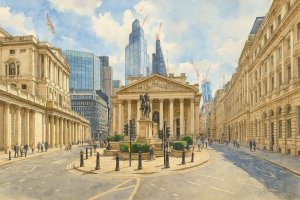 Map of Bank, London
Map of Bank, London
The Origin of the name "Bank"
The name "Bank" comes from the Bank of England, which was established in 1694. Initially founded to manage government debt and serve as the country's central bank, the institution's presence in the area has made "Bank" a shorthand for financial activity in the city. Over time, the area surrounding the Bank of England has developed into one of the most vital commercial centres in the world.
Watercolour painting of Bank, London
Major Streets in the Bank Area
Several key streets run through the Bank area, each contributing to its distinct atmosphere of commerce and history. These include:- Threadneedle Street: Home to the Bank of England, this street has long been at the heart of London's financial scene.
- Lombard Street: Known for its banking heritage, this historic street is where London's banking sector began.
- King William Street: A major road connecting the Bank area to Monument and London Bridge.
- Cornhill: A historic street linking to the Royal Exchange, another key site in the City's financial history.
Bank Tube Station
Bank station is one of London's busiest and most significant transport hubs. It is served by multiple Underground lines, including Central Line, Northern Line, Waterloo & City Line and Docklands Light Railway (DLR). This extensive coverage makes Bank station an essential part of London's transport network, connecting commuters and tourists alike to the heart of the city.Monument Tube Station
Although Monument Tube Station is located nearby, it is generally not considered part of the Bank area itself. It sits at the southern end of the Bank area, near the famous Monument to the Great Fire of London. However, both stations are often linked in people's minds due to their proximity and their role in London's financial district.Fun Facts about the Bank area
- The Bank of England: Often referred to as "The Old Lady of Threadneedle Street," the Bank of England is one of the world's oldest central banks and remains a key institution in the city's financial landscape.
- Monument to the Great Fire: Located near Monument station, this 202-foot tall column commemorates the Great Fire of London, which started in 1666. Visitors can climb to the top for stunning views of the city.
- Stock Exchange: The Royal Exchange, located on Cornhill, was once home to the London Stock Exchange and remains a symbol of the city's trading heritage.
The Bank area blends historic architecture with modern finance, making it one of the most recognizable parts of London. Whether you're exploring its iconic streets, taking in its landmarks, or learning about the financial systems that run through it, the Bank area offers something for every visitor and resident.
List of Places in London, Map of Places in London

Copyright © 2003-2025 Timothy Tye. All Rights Reserved.

 Go Back
Go Back